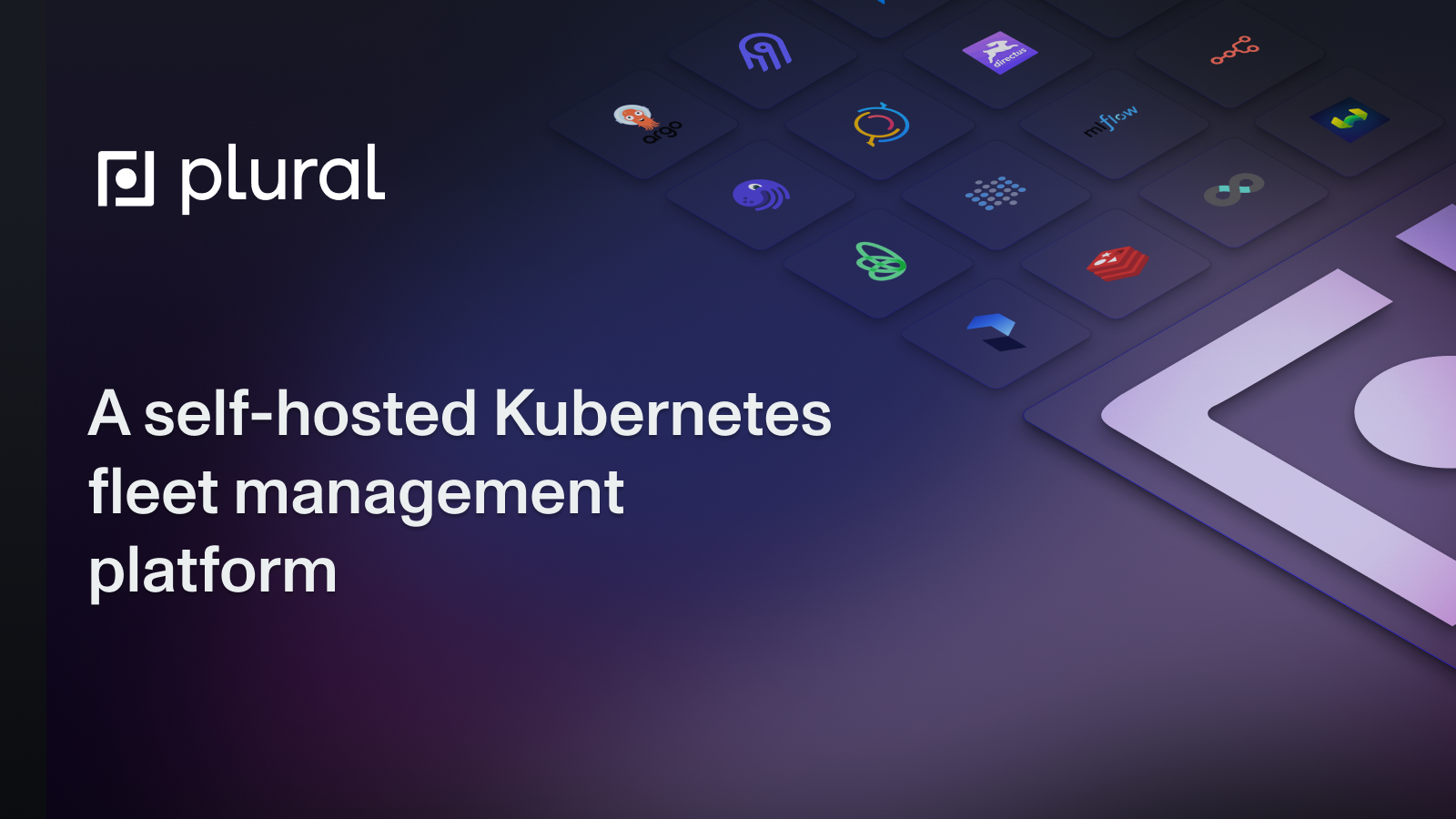
Managing Kubernetes Clusters in the Real World
Explore real-world Kubernetes use cases and learn about managing Kubernetes operating Kubernetes clusters in the real world for various industries.
Kubernetes has become essential for modern infrastructure, orchestrating containerized applications with incredible efficiency. But the real-world operational challenges of managing Kubernetes clusters can be significant. This guide explores practical strategies for managing Kubernetes, aligning with a real-world focus. Whether you're dealing with multi-cluster deployments, security concerns, or optimizing Kubernetes workflows, this guide offers actionable insights and best practices for enterprise Kubernetes.
This comprehensive guide explores the core concepts of Kubernetes, its key features, and how it's transforming industries. We'll delve into real-world Kubernetes use cases, best practices for implementation, and the future of this transformative technology. Whether you're a seasoned DevOps engineer or just beginning your Kubernetes journey, this guide provides valuable insights and actionable steps to harness the full potential of Kubernetes.
Streamlined Cloud Orchestration for Kubernetes
Manage Kubernetes at scale through a single, enterprise-ready platform.
Key Takeaways
- Kubernetes is the industry standard for container orchestration: It automates key processes, improving resource utilization and application reliability. Features like automated scaling and self-healing are crucial for managing complex deployments.
- Kubernetes supports diverse workloads and environments: From stateful applications requiring persistent storage to stateless microservices, Kubernetes offers the flexibility to manage various application types across hybrid and multi-cloud environments.
- Successful Kubernetes adoption requires a strategic approach: Prioritize security, implement best practices for deployments and monitoring, and leverage tools like Plural to simplify management and enhance visibility across your Kubernetes fleet.
Introduction to Managing Kubernetes Clusters
Kubernetes has revolutionized application deployment and management, but the growing complexity of managing numerous Kubernetes clusters presents new challenges. As organizations expand their Kubernetes deployments, they often grapple with sprawling infrastructure requiring careful orchestration and streamlined management. Managing multiple clusters is like conducting an orchestra: one musician is simple, but coordinating many instruments requires a skilled conductor and a well-defined score.
Managing a large number of Kubernetes clusters introduces significant operational overhead. While Cluster API offers a robust solution for provisioning and managing clusters, succeeding with it requires substantial custom work and careful planning, as discussed in conversations about managing Kubernetes at scale. Like a conductor needing a deep understanding of each instrument and their interactions, managing a fleet of Kubernetes clusters requires comprehensive knowledge of individual configurations and interdependencies. This includes aspects like resource allocation, network policies, and security configurations.
A well-defined management strategy is crucial for navigating these complexities. Industry best practices emphasize a holistic approach to Kubernetes management, encompassing everything from architecture and installation to security and monitoring. This is similar to a conductor not only directing the music but also ensuring tuned instruments, prepared musicians, and an acoustically optimized concert hall. Effective Kubernetes management requires similar attention to detail, from initial setup and configuration to ongoing maintenance and optimization. Leveraging a platform like Plural can streamline these efforts, providing centralized control and automation.
Successfully adopting and scaling Kubernetes requires a strategic approach. Prioritizing security, implementing best practices for deployments and monitoring, and using tools to simplify management are essential for a healthy, efficient Kubernetes fleet. Tools like Plural enhance visibility and control across clusters, offering a centralized platform for managing configurations, deployments, and security policies. Like a conductor’s baton guiding the orchestra, a robust management platform provides the tools and insights to orchestrate your Kubernetes infrastructure effectively.
Kubernetes Explained
Kubernetes (K8s) orchestrates containerized applications at scale. Instead of running applications on individual machines, you package them into containers—lightweight, portable units bundling application code and dependencies. Think of containers as self-contained packages, and Kubernetes as the system managing these packages across a cluster of machines. This approach shifts away from managing individual servers to managing application deployments, improving resource utilization and application reliability. Kubernetes automates deployments, scaling, and management, becoming the industry standard for container orchestration and a key component of modern IT infrastructure.
Essential Kubernetes Features for Enterprise
Kubernetes has become essential for enterprises modernizing their infrastructure and application deployments. Its architecture offers specific features that address the challenges of managing complex, distributed systems at scale. Let's examine some key features that make Kubernetes well-suited for enterprise use.
Scaling Kubernetes Effectively
Kubernetes excels at scaling applications and their underlying infrastructure. Whether dealing with predictable or unpredictable traffic spikes, Kubernetes automatically adjusts the number of running containers to meet demand. This dynamic scaling ensures optimal resource utilization and application performance. Horizontal Pod Autoscaler (HPA) is a core component of this functionality, allowing you to define scaling rules based on CPU utilization, memory usage, or even custom metrics. For example, you could configure Kubernetes to automatically scale up the number of pods running a web application during peak traffic hours and scale down during off-peak hours, optimizing resource usage and cost.
Managing Multiple Kubernetes Clusters
Managing multiple Kubernetes clusters across diverse environments is another strength. Enterprises often operate in hybrid or multi-cloud scenarios, requiring a consistent management layer across all deployments. Kubernetes provides tools and APIs to deploy, monitor, and manage applications across these disparate environments, simplifying operations and ensuring consistency. This multi-cluster management capability is crucial for maintaining control and visibility across a distributed infrastructure. Tools like Plural further enhance this by providing a single pane of glass for managing your entire Kubernetes fleet. For instance, you can use Kubernetes to deploy the same application to clusters running on AWS, Azure, and Google Cloud, and manage them all from a central location.

Challenges of Multi-Cluster Management
While Kubernetes offers robust tools and APIs for managing applications across diverse environments, effectively orchestrating multiple Kubernetes clusters presents unique challenges. Maintaining consistency across these clusters, especially in hybrid or multi-cloud scenarios, can become complex. Ensuring consistent security policies, resource allocation, and application deployments requires careful planning and the right tooling. Without a centralized management layer, operational overhead increases significantly as the number of clusters grows. This can lead to inconsistencies, security vulnerabilities, and difficulties in troubleshooting issues across the distributed infrastructure.
Copy-Pasting Configurations and Legacy Issues
One common pitfall in multi-cluster Kubernetes management is the tendency to copy-paste configurations. This seemingly simple approach quickly creates technical debt and scalability issues. As configurations diverge across clusters, managing updates and ensuring consistency becomes a nightmare. Troubleshooting is also hampered, as seemingly identical clusters can exhibit different behaviors due to subtle configuration drifts. This problem is further compounded when dealing with hundreds of clusters, as discussed in community discussions regarding Azure Kubernetes Service (AKS) and Cluster API. Avoiding copy-pasting and implementing robust configuration management practices are crucial for long-term success with multi-cluster Kubernetes.
Observability at Scale
Gaining comprehensive visibility into the performance and health of applications running across multiple Kubernetes clusters is another significant challenge. Traditional monitoring tools often struggle to provide a unified view across a distributed environment. Implementing effective observability at scale requires specialized tools and strategies. As highlighted in discussions on managing large numbers of clusters, tools like Opni and SigNoz offer promising approaches to collecting and analyzing metrics, logs, and traces. Choosing the right observability tools and integrating them effectively into your Kubernetes workflows is essential for maintaining control and quickly identifying and resolving issues in a multi-cluster environment. For more insights on observability tools and best practices, explore resources like this Reddit thread.
Alternative Tools and Approaches
Several tools and approaches aim to simplify multi-cluster Kubernetes management. Platforms like Rancher and Gardener offer centralized management capabilities, enabling consistent deployments and policy enforcement across multiple clusters. Sveltos provides another approach to deploying and managing applications. These tools offer various features, from simplified cluster provisioning and lifecycle management to enhanced observability and security. Evaluating these alternatives and choosing the right solution for your specific needs is crucial for optimizing your multi-cluster Kubernetes strategy. For enterprise-grade management and streamlined workflows, platforms like Plural offer a comprehensive solution for managing Kubernetes at scale, addressing the challenges of multi-cluster deployments with features like GitOps-based deployments, secure dashboards, and Infrastructure-as-Code management.
Automating Kubernetes Operations
Automation is a core tenet of Kubernetes, enabling self-service workflows and reducing manual intervention. Platform teams can define application deployment and management processes as code, allowing developers to deploy and update applications independently. This self-service access accelerates development cycles and empowers development teams. Features like automated rollouts and rollbacks further reduce risk and ensure smooth deployments. This allows developers to quickly iterate on their applications and push changes to production without requiring manual intervention from operations teams.
Securing Your Kubernetes Clusters
Security is paramount in enterprise environments. Kubernetes offers robust security features, including Role-Based Access Control (RBAC), network policies, and secrets management. These features allow granular control over access to resources and ensure that security policies are consistently enforced across the entire Kubernetes environment. This focus on security helps enterprises meet compliance requirements and protect sensitive data. By leveraging these security features, organizations can build and operate secure and compliant Kubernetes deployments. For example, RBAC allows you to define roles and permissions for different teams and individuals, ensuring that only authorized personnel can access sensitive resources. Network policies allow you to control traffic flow between pods and namespaces, isolating applications and reducing the impact of security breaches.
Real-World Kubernetes Use Cases
Kubernetes has become an essential infrastructure for organizations across various sectors. Its flexibility and scalability make it a powerful tool for managing containerized applications, regardless of industry.
Kubernetes in Finance and AI
Major financial institutions have embraced Kubernetes to solve critical infrastructure challenges. Bloomberg adopted Kubernetes in 2016 to standardize deployment processes for their 14,000+ Terminal applications, achieving remarkable 90-95% hardware utilization rates while processing hundreds of billions of data pieces daily. Similarly, ING implemented it as part of their agile transformation, building an internal cloud for CI/CD pipelines that significantly improved development speed and reduced costs. AI and ML workloads present unique infrastructure challenges, requiring substantial computing resources that can scale dynamically based on training and inference demands. OpenAI, a leader in artificial intelligence research and deployment, leverages Kubernetes to orchestrate its extensive AI infrastructure. Their computational workloads require massive parallel processing capabilities for training large language models and other AI systems. Kubernetes enables OpenAI to efficiently distribute these intensive workloads across GPU clusters, dynamically scale resources based on training demands, and maintain high availability for their AI services. This infrastructure flexibility allows OpenAI to focus on pushing the boundaries of AI research rather than managing complex computing environments.
Kubernetes for Healthcare and Research
In healthcare and scientific research, data security and regulatory compliance are paramount. Kubernetes helps organizations in these sectors meet these requirements while enabling faster innovation. Large research facilities, like CERN, use Kubernetes to manage their extensive computing resources, improving efficiency and resilience. CERN, after migrating to Kubernetes, saw a 15% reduction in virtualization overhead. This allows researchers to focus on their work rather than managing infrastructure. The platform also facilitates the deployment of portable and scalable healthcare applications, enabling faster diagnosis and treatment. Babylon Health is another notable example in the healthcare sector. By leveraging Kubernetes, Babylon Health has significantly enhanced its ability to orchestrate complex machine-learning experiments and clinical validations. This has reduced the time for clinical validation from up to 10 hours to under 20 minutes, allowing for parallel processing of multiple validations simultaneously.
Kubernetes in E-commerce and Retail
E-commerce and retail companies operate in a highly competitive environment where application performance directly impacts revenue. Kubernetes has become a cornerstone technology for these businesses, enabling them to handle unpredictable traffic patterns, seasonal spikes, and the constant push for innovation. JD.com, one of China's largest online retailers, utilized Kubernetes to prepare for high-demand events like Singles Day. This implementation allowed them to handle $23 billion in transactions over just 11 days, reduced deployment times from several hours to tens of seconds, and improved IT costs by 20-30%. Similarly, Adidas embraced Kubernetes to modernize their digital infrastructure, transitioning 40% of their business-critical systems within just one year. This move dramatically reduced their provisioning time and infrastructure costs while improving their ability to serve customers across global markets.
Kubernetes for Media and Entertainment
Media and entertainment companies deal with massive datasets and require high availability to deliver content seamlessly. Organizations in this industry leverage Kubernetes to manage and scale their infrastructure, ensuring content is always accessible to consumers. The New York Times migrated customer-facing applications to Kubernetes, reducing deployment times from 45 minutes to just a few seconds. Developers gained autonomy to push updates independently, improving productivity and flexibility in delivering news content to readers. Spotify uses Kubernetes to manage their complex microservices architecture, enabling them to deliver music to millions of users worldwide. Similarly, Tinder migrated 200 services to Kubernetes, managing a cluster with 1,000 nodes, 15,000 pods, and 48,000 containers. This allowed Tinder to handle 250,000 DNS requests per second and improve operational efficiency. This scalability and reliability are crucial for maintaining a competitive edge in the fast-paced media landscape.
Kubernetes in Telecom and Network Functions
Telecommunications companies are increasingly adopting cloud-native technologies to modernize their networks. Kubernetes plays a crucial role in this transformation by enabling the deployment and management of network functions virtualization (NFV) workloads. Nokia, a global leader in telecom infrastructure, faced the challenge of delivering its software across diverse operator environments, ranging from bare metal to VMware and OpenStack. To address this, Nokia embraced Kubernetes and containerization, enabling infrastructure-agnostic behavior in its products. The benefits realized by Nokia—such as reduced operational complexity, faster deployment cycles, and enhanced scalability—demonstrate how Kubernetes can revolutionize network functions virtualization (NFV) in telecommunications. By leveraging these technologies, telecom providers can deploy and scale new services more efficiently while maintaining flexibility across multi-cloud environments.
Deep Dive into Managing Kubernetes (Book Review)
For those looking to solidify their Kubernetes expertise, "Managing Kubernetes: Operating Kubernetes Clusters in the Real World" by Brendan Burns and Craig Tracey is a valuable resource. Let's explore what this book offers and why it might be the right choice for you.
Overview of "Managing Kubernetes"
Aimed at system reliability and DevOps engineers, this book provides practical guidance for managing Kubernetes clusters in production. It goes beyond the basics, offering insights into the day-to-day challenges and solutions involved in operating Kubernetes at scale. Whether you're troubleshooting a complex issue or planning a major upgrade, this book equips you with the knowledge and strategies to effectively manage your Kubernetes infrastructure.
Key Topics Covered
“Managing Kubernetes” delves into the intricacies of building, operating, managing, and upgrading Kubernetes clusters. The authors explain Kubernetes's internal workings, providing a deeper understanding of how the system functions. This knowledge is crucial for effective troubleshooting and optimization. The book covers essential topics for managing Kubernetes in production, including cluster design, access control using RBAC, monitoring, alerting, and upgrades. It also addresses practical considerations like capacity planning and resource management, helping you optimize your Kubernetes deployments. For teams working with multiple clusters, like those using a platform like Plural, the insights into multi-cluster management are particularly relevant.
Target Audience and Benefits
With a 4.4 out of 5-star rating on Amazon, based on 55 reviews, "Managing Kubernetes" is well-regarded within the Kubernetes community. While not strictly a beginner's guide, it offers immense value to those already working with Kubernetes and seeking to deepen their understanding. The book provides actionable advice and best practices, directly applicable to real-world Kubernetes environments. This practical focus makes it a valuable asset for anyone responsible for operating and maintaining Kubernetes clusters.
Where to Access the Book
You can access "Managing Kubernetes" through a 10-day free trial of O'Reilly's learning platform. This platform offers a wealth of resources, including access to over 60,000 other books, live events, and job role-specific courses. Continued access to O'Reilly's extensive library can be a valuable investment for any tech professional.
Modernizing Microservices with Kubernetes
Kubernetes is particularly well-suited for managing the intricacies of microservices architectures. It offers features that simplify complex deployments and improve the reliability and scalability of applications built with a microservices approach.
Automated Scaling and Self-Healing with Kubernetes
Microservices-based applications often consist of dozens or even hundreds of interconnected services. Kubernetes excels at managing this complexity. It provides automated scaling, allowing you to easily adjust the number of replicas of a service based on demand. This ensures your application can handle traffic spikes and maintain performance under pressure. If a service fails, Kubernetes automatically restarts it, minimizing downtime and maintaining the overall health of your application. This self-healing capability is crucial for ensuring high availability and a positive user experience. For example, if a shopping cart service within an e-commerce application experiences a surge in traffic, Kubernetes can automatically scale up the number of instances to handle the increased load.
Service Discovery and Load Balancing in Kubernetes
In a microservices architecture, services need to discover and communicate with each other dynamically. Kubernetes simplifies this with built-in service discovery and load balancing. Services can locate each other without needing hardcoded addresses, and traffic is distributed evenly across available instances. This ensures no single instance becomes overloaded and improves the resilience of the system. Imagine a scenario where a user authentication service is running on multiple pods. Kubernetes load balancing ensures that incoming authentication requests are distributed across all available pods, preventing bottlenecks and ensuring consistent performance.
Configuration Management in Kubernetes
Managing application configuration across a distributed microservices architecture can be challenging. Kubernetes streamlines this process with ConfigMaps and Secrets. ConfigMaps allow you to store non-sensitive configuration data, while Secrets securely manage sensitive information like API keys and database credentials. This centralized approach simplifies configuration updates and reduces the risk of errors. For instance, if you need to update a database connection string for multiple services, you can modify the corresponding Secret in Kubernetes, and the changes will be automatically propagated to all affected services. This eliminates the need to manually update configurations on individual instances, saving time and reducing the potential for human error. Tools like Plural further enhance this by providing a unified platform to manage Kubernetes deployments and configurations across your entire infrastructure.

Kubernetes as a DevOps Catalyst
Kubernetes is a powerful tool for DevOps teams, enabling automation, collaboration, and faster release cycles. It streamlines deployments, manages infrastructure, and provides consistent environments, increasing overall productivity. Let's explore how Kubernetes enhances key DevOps practices.
Streamlining CI/CD with Kubernetes
Kubernetes integrates with popular CI/CD tools like Jenkins, GitLab CI/CD, and CircleCI. This integration automates the entire software delivery pipeline, from building and testing to deployment and rollback. Teams define their deployment process in configuration files, ensuring consistent and repeatable deployments across different environments. This automation reduces manual intervention, minimizes errors, and accelerates the delivery of features and updates. Kubernetes also supports canary deployments and blue/green deployments, allowing teams to test new releases in production with minimal risk.
IaC and GitOps with Kubernetes
Kubernetes enables infrastructure as code (IaC), allowing you to define and manage your infrastructure through configuration files. This approach, combined with GitOps practices, brings version control and collaboration to infrastructure management. Teams can store their Kubernetes configurations in a Git repository, tracking changes and enabling peer reviews. This approach ensures that infrastructure changes are auditable, repeatable, and easily rolled back. GitOps also promotes collaboration among team members, fostering shared responsibility and continuous improvement. Tools like Argo CD and Flux further enhance GitOps workflows by automating the deployment and synchronization of Kubernetes configurations.
Plural’s Approach to GitOps and IaC
Plural simplifies Kubernetes management by integrating GitOps and Infrastructure as Code (IaC) principles. Managing infrastructure should be as streamlined and collaborative as managing application code. Our platform enables you to define and manage your entire Kubernetes infrastructure through configuration files stored in a Git repository. This approach provides several key benefits:
- Version Control: Track every infrastructure change, making it easy to revert to previous states. This provides a clear audit trail and simplifies troubleshooting.
- Collaboration: Enable peer reviews and collaboration on infrastructure changes, fostering shared responsibility and knowledge sharing within your team. This mirrors how developers collaborate on application code, leading to better infrastructure design and fewer errors.
- Automation: Automate deployments and updates through GitOps workflows. Plural integrates with tools like Argo CD and Flux, ensuring your infrastructure remains synchronized with your Git repository. This eliminates manual processes and reduces the risk of human error.
- Simplified Rollbacks: If a deployment goes wrong, quickly revert to a previous stable state using your Git history. This minimizes downtime and simplifies incident management.
- Reproducibility: Easily recreate your Kubernetes environments in different contexts (e.g., staging, production) using the same configuration files. This ensures consistency and reduces the risk of configuration drift.
With Plural, managing your Kubernetes infrastructure becomes as simple as managing your application code, allowing you to focus on building and deploying applications. Book a demo to see how Plural can transform your Kubernetes workflows.
Consistent Development with Kubernetes
Kubernetes simplifies the creation of consistent development environments across the entire development lifecycle. Developers can spin up local Kubernetes clusters using tools like Minikube or Kind, mirroring the production environment on their local machines. This consistency eliminates the "it works on my machine" problem, reducing integration issues and streamlining debugging. Kubernetes also facilitates creating staging and testing environments that closely resemble production, enabling more realistic testing and reducing the risk of deployment failures. By providing consistent environments, Kubernetes improves collaboration among developers and ensures a smoother transition from development to production.
Kubernetes for Hybrid and Multi-Cloud Deployments
Kubernetes is a powerful tool for managing containerized applications across diverse environments, including hybrid and multi-cloud deployments. This flexibility allows businesses to avoid vendor lock-in, optimize resource allocation, and adapt to evolving infrastructure needs.
Portability Across Cloud Environments with Kubernetes
Kubernetes abstracts away the underlying infrastructure details, providing a consistent platform for running applications across different environments. This portability simplifies migrating applications between on-premises data centers and various cloud providers like AWS, Azure, and Google Cloud. Teams can deploy and manage applications consistently, regardless of the underlying infrastructure, reducing complexity and accelerating development cycles. This approach ensures consistent application behavior and simplifies management.
Consistent Management and Orchestration with Kubernetes
Managing large-scale Kubernetes deployments across multiple environments presents significant challenges. Maintaining consistency and interoperability requires robust tooling and automation. Platforms like Plural offer centralized management and orchestration capabilities, enabling teams to deploy and manage applications consistently across their entire hybrid or multi-cloud environment. Features like GitOps integrations, automated rollouts, and centralized monitoring simplify operations and reduce the risk of configuration drift.

Plural as a Solution for Multi-Cloud Kubernetes Management
Managing Kubernetes across multiple clouds and on-premises infrastructure presents significant challenges. Maintaining consistency, ensuring security, and streamlining operations become increasingly complex as your Kubernetes footprint grows. Plural simplifies multi-cloud Kubernetes management by providing a single, unified platform for controlling and monitoring all your clusters, regardless of location.
With Plural, you deploy and manage applications consistently across AWS, Azure, Google Cloud, or your own on-premises infrastructure. This eliminates the need for separate tools and processes for each environment, reducing operational overhead and ensuring consistent application behavior. Deploy a complex application stack with identical configurations across all your environments with just a few clicks.
Plural's agent-based architecture enhances security by eliminating the need for direct access to your workload clusters. The agent, installed in each cluster, communicates with the central Plural control plane, receiving instructions and reporting back status. This approach minimizes the attack surface and ensures cluster security. The control plane itself can be deployed on any Kubernetes cluster, giving you the flexibility to manage your entire fleet from a location of your choosing.
Beyond deployment, Plural streamlines ongoing operations. Simplified upgrades, centralized dashboards, and robust configuration management improve visibility and control. Troubleshooting becomes easier with a unified view of all your clusters, and automated compliance checks help ensure that your deployments adhere to industry best practices and regulatory requirements. Plural empowers your team to focus on building and deploying applications, not wrestling with infrastructure.
Optimizing Resources and Costs with Kubernetes
Kubernetes optimizes resource utilization by efficiently scheduling containers across available compute resources. This leads to better hardware utilization and cost savings, especially in multi-cloud environments where resource pricing can vary significantly. By dynamically allocating resources based on application demand, Kubernetes helps avoid over-provisioning and reduces wasted cloud spend. Teams can leverage Kubernetes to take advantage of spot instances or preemptible VMs in the cloud, further optimizing costs.
Security and Compliance in Kubernetes
Security and compliance are paramount when running Kubernetes in production. A robust security posture isn't just a best practice; it's a necessity. Here's how to approach security and compliance in your Kubernetes deployments:
Implementing RBAC in Kubernetes
RBAC is fundamental to Kubernetes security. It lets you define granular permissions based on roles, ensuring that users and services only access the resources they need. This principle of least privilege minimizes the potential impact of security breaches. Start by defining roles that align with job functions within your organization. Then, bind those roles to specific users or groups. Regularly review and refine these RBAC policies to adapt to evolving needs and potential threats. Tools like Plural can simplify RBAC management across an entire fleet. For example, you can use Plural to define RBAC policies centrally and automatically deploy them to all your clusters, ensuring consistency and reducing administrative overhead. This centralized approach to RBAC is crucial for managing Kubernetes at scale.
Network Policies and Isolation in Kubernetes
Network policies act as firewalls within your cluster, controlling traffic flow between pods and namespaces. By default, all pods can communicate with each other, a significant security risk. Network policies allow you to specify which pods can communicate with each other and with external services, limiting the impact of a compromised pod. Think of network policies as defining "allowed" communication paths; anything not explicitly allowed is denied. This zero-trust approach significantly improves your cluster's security. When defining network policies, consider segmenting your cluster into different namespaces based on application tiers or security requirements. This segmentation allows for more granular control over network traffic and further isolates sensitive workloads.
Compliance and Auditing in Kubernetes
Auditing provides a crucial record of all activity within your Kubernetes cluster. This includes API calls, changes to resources, and security-related events. Comprehensive audit logs are essential for compliance with industry regulations and internal security policies. They provide the necessary data for investigating security incidents, understanding user behavior, and demonstrating compliance to auditors. Make sure your audit logs are stored securely and are readily available for analysis. Consider integrating your audit logs with a centralized security information and event management (SIEM) system for real-time monitoring and alerting. Kubernetes provides built-in audit logging capabilities, but managing and analyzing these logs can be challenging, especially across a large fleet. Tools like Plural can streamline this process by aggregating audit logs from all your clusters into a central location, making it easier to monitor, analyze, and ensure compliance.
Best Practices for Operating Kubernetes
Successfully implementing Kubernetes requires a well-defined strategy and adherence to best practices. These practices span various aspects of Kubernetes management, from initial setup and configuration to ongoing maintenance and security.
Roles and Responsibilities in Kubernetes
Kubernetes introduces new operational paradigms, so ensure your team understands their respective roles in managing the cluster. Establish clear communication channels and processes for incident response and change management. This clarity helps prevent conflicts and ensures smoother operations.
Kubernetes Security Best Practices
Integrate security measures into your fleet management strategy from the outset. This allows for consistent enforcement of security policies across your entire Kubernetes environment. Regularly audit your configurations, implement network policies, and use role-based access control (RBAC) to restrict access to sensitive resources. Consider using policy-as-code tools to manage and automate security policies.
Deploying Kubernetes in Multiple Environments
Develop a robust strategy to handle deployments across different environments while maintaining consistency and interoperability. Utilize tools and techniques like GitOps to automate deployments and ensure configuration consistency. Employ a consistent CI/CD pipeline for all environments to minimize discrepancies and streamline the deployment process.
Visibility in Kubernetes
Implement comprehensive monitoring and logging solutions to gain insights into the health and performance of your applications and infrastructure. Tools like Prometheus and Grafana can provide valuable dashboards and alerts, enabling proactive issue identification and resolution. Plural itself offers features to enhance visibility and control over your Kubernetes clusters and services. Centralize logs and metrics to provide a unified view of your entire Kubernetes environment.
Managing Kubernetes at Scale
As your Kubernetes deployments grow, efficient management becomes increasingly important. Adopt automation wherever possible to streamline tasks like deployments, scaling, and resource management. Efficient management is key to ensuring consistency, security, and reliability across your fleet as it scales. Consider using a platform like Plural to centralize management and simplify operations. Implement Infrastructure-as-Code (IaC) to manage your Kubernetes infrastructure and automate cluster provisioning.
Using Plural for Simplified Kubernetes Management at Scale
Managing Kubernetes at scale can feel overwhelming. You’re juggling multiple clusters, deployments, and configurations across different environments. It becomes complex, time-consuming, and prone to errors. This is where a platform like Plural shines, offering a streamlined approach to managing your entire Kubernetes fleet.
Plural provides a single pane of glass for your Kubernetes operations. Instead of switching between different tools and consoles, you manage everything from a central location. This centralized management simplifies deployments, monitoring, and troubleshooting, saving you time and reducing operational overhead. Deploying a new application version across dozens of clusters with just a few clicks becomes a reality.
Beyond simplified management, Plural enhances visibility across your Kubernetes deployments. You gain a clear overview of all your clusters, their health status, resource utilization, and application performance. This enhanced visibility allows you to proactively identify and address potential issues, ensuring the reliability and stability of your applications. For compliance and security auditing, Plural aggregates audit logs from all your clusters into a central, manageable location.
Plural leverages GitOps principles, integrating with your existing Git workflows. Your entire Kubernetes configuration, from deployments to infrastructure as code, is managed through Git. This approach ensures version control, auditability, and easy rollback capabilities. Changes are reviewed and approved through pull requests, promoting collaboration and reducing the risk of errors. Plural’s automation capabilities extend to infrastructure management, allowing you to provision and manage your Kubernetes infrastructure using tools like Terraform, all within the same platform.
Related Articles
- Kubernetes Orchestration: A Comprehensive Guide
- Deep Dive into Kubernetes Components
- Kubernetes Mastery: DevOps Essential Guide
- Your Guide to Kubernetes Cluster Management
- Simplify Operations with Kubernetes Management Platform
Streamlined Cloud Orchestration for Kubernetes
Manage Kubernetes at scale through a single, enterprise-ready platform.
Frequently Asked Questions
Why is Kubernetes important for modern software development?
Kubernetes has become essential for managing containerized applications, offering automation, scalability, and improved resource utilization. It simplifies deploying, scaling, and managing complex applications, enabling faster release cycles and more resilient infrastructure. This shift from managing individual servers to managing application deployments is a key component of modern IT strategies.
How does Kubernetes handle scaling and resource management?
Kubernetes automatically adjusts resources based on application demand. Features like the Horizontal Pod Autoscaler allow you to define scaling rules based on metrics like CPU usage or memory consumption. This dynamic scaling ensures optimal resource utilization and application performance, even during traffic spikes. This automation simplifies operations and ensures your applications can handle varying loads.
What are the security features of Kubernetes?
Kubernetes offers robust security features, including Role-Based Access Control (RBAC), network policies, and secrets management. RBAC allows granular control over access to resources, while network policies control traffic flow between pods. Secrets management secures sensitive information like API keys. These features help organizations meet compliance requirements and protect sensitive data.
How does Kubernetes support microservices architectures?
Kubernetes simplifies managing microservices with features like automated scaling, service discovery, and load balancing. It automatically adjusts the number of service instances based on demand and enables services to locate each other dynamically. This ensures no single instance becomes overloaded and improves system resilience. Kubernetes also streamlines configuration management for microservices, simplifying updates and reducing errors.
What are the key trends shaping the future of Kubernetes?
Key trends include increased adoption of multi-cloud and hybrid deployments, enhanced security and compliance measures, the rise of serverless Kubernetes and abstraction, deeper integration with AI and machine learning, and a continuously growing ecosystem of tools and platforms. These trends reflect the evolving needs of organizations adopting Kubernetes for modern application development and deployment.
Newsletter
Join the newsletter to receive the latest updates in your inbox.












